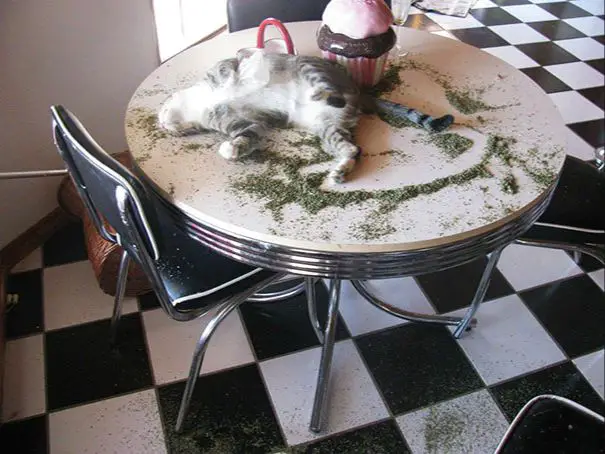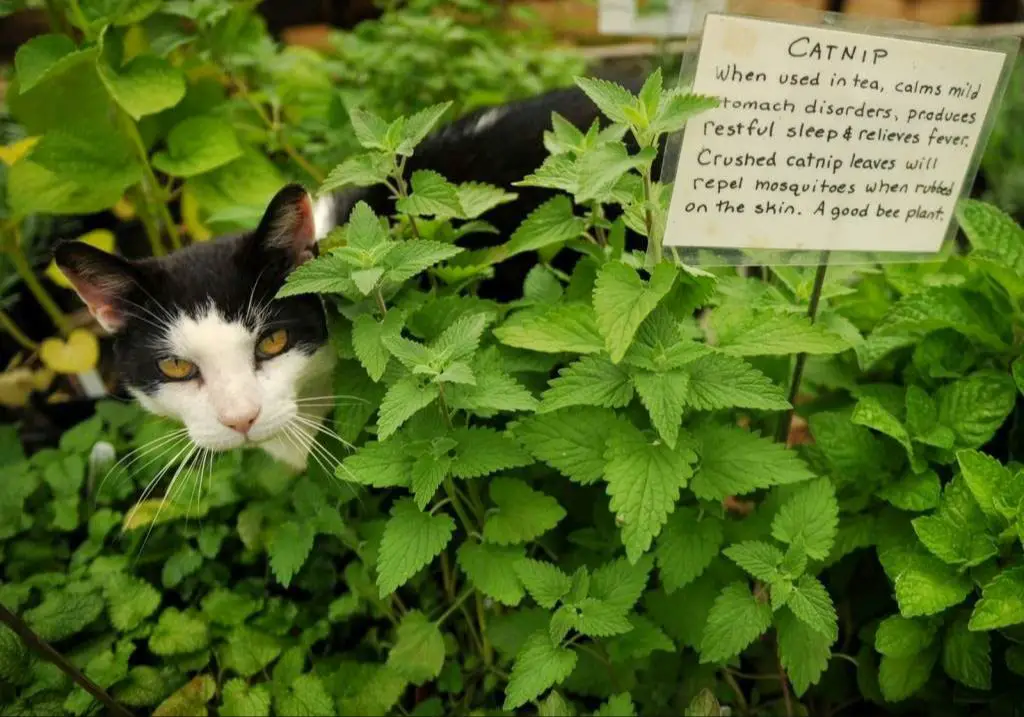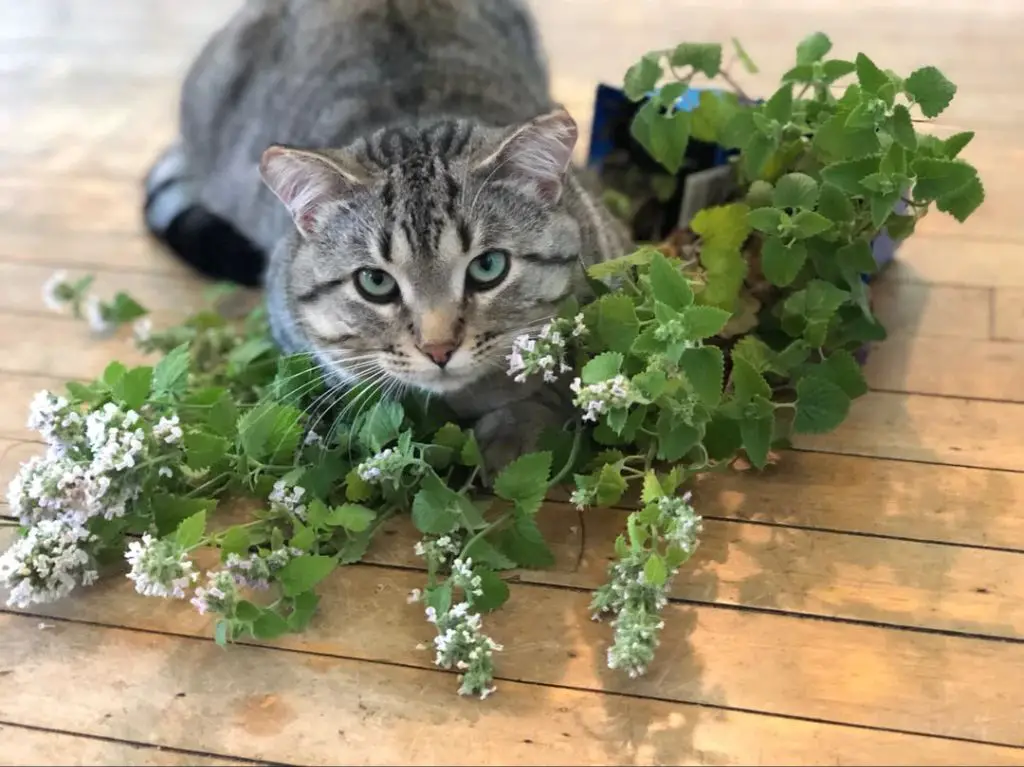What is catnip?
Catnip, also known as catmint or Nepeta cataria in Latin, is an herb in the mint family. It is a perennial flowering plant with gray-green leaves and small lavender flowers. The leaves and stems contain nepetalactone, an organic compound that acts as a cat attractant.[1]
When cats smell or ingest catnip, the nepetalactone binds to receptors in their noses and stimulates a response that researchers believe mimics the effects of cat pheromones. This causes most cats to act playful, excitable, affectionate or relaxed when exposed to catnip.[2]
Not all cats respond to catnip. Sensitivity is an inherited trait and it usually does not emerge until a cat is 3-6 months old. Around 50-70% of cats are believed to respond to catnip.[1]
Catnip is not considered toxic or addictive to cats when used appropriately. The effects wear off after 5-15 minutes. It provides cats with harmless sensory stimulation.[2]

Sources:
[1] https://www.humanesociety.org/resources/crazy-catnip
[2] https://www.petmd.com/cat/general-health/what-is-catnip
Why do cats like catnip?
Catnip contains an essential oil called nepetalactone that elicits a unique response in cats (Purina). When cats smell or ingest catnip, the nepetalactone binds to receptors in their noses and stimulates a response that researchers believe mimics the effects of feline pheromones. This triggers a euphoric reaction that makes cats go crazy with delight and exhibit playful behavior like rolling, flipping, and jumping.
According to science.org, studies show that nepetalactone activates cats’ opioid systems in a way similar to how heroin and morphine activate opioid systems in humans. The primary chemicals in catnip essentially act like cat drugs, inducing a temporary sense of pleasure and giddiness.
So in summary, the response to nepetalactone, the mimicking of natural pheromones, and the activation of the opioid system are three key reasons why cats love catnip and react so strongly to its presence.
Is it okay to give catnip to cats?
Generally, catnip is considered safe for adult cats to enjoy in moderation. The herb contains a chemical called nepetalactone, which triggers a euphoric response when cats smell or ingest it. Most cats react to catnip by becoming more playful, affectionate, energetic, and even silly.
While overstimulation is rarely an issue, some cats may become overactive after too much catnip. Starting with small amounts and supervising your cat while exposed to catnip is recommended. Stop providing catnip if your cat shows signs of agitation or anxiety from it.

Catnip should also be avoided for kittens under 6 months old, as their brains are still developing and they do not need strong external stimulants at this young age. Once a kitten reaches 6-12 months old, catnip can be introduced slowly and in moderation.
Overall, catnip is considered very safe for most adult cats. However, each cat has a unique personality and tolerance level. Get to know how your individual cat responds before offering unlimited access to catnip.
Should you crush catnip before giving it to cats?
Crushing catnip before giving it to cats helps release the oils and makes the scent stronger, which can be more attractive and exciting for cats (1). The act of crushing brings out nepetalactone, the chemical compound in catnip that causes the euphoric reaction in cats (2).
Lightly crushing the catnip leaves is recommended, as too finely crushed catnip can be overwhelming and overstimulating for cats. Kittens and cats unfamiliar with catnip should be given uncrushed or lightly crushed catnip at first (3).
So crushing catnip can make it more enticing and fun for cats, but moderation is key. Lightly bruise the leaves between your fingers or give your cat whole catnip leaves to chew on.
(1) https://www.wikihow.com/Give-Catnip-to-Your-Cat
(2) https://www.aspcapetinsurance.com/resources/what-does-catnip-do-to-cats/
(3) https://www.petcarerx.com/article/is-catnip-safe-5-things-you-should-know/81
How much catnip should you give?
The amount of catnip you should give your cat depends on the form of the catnip. Catnip can be given dried, fresh, or as an oil. It’s generally recommended to start with small amounts, especially if giving it for the first time, and monitor your cat’s reaction.
If using dried catnip, start with a teaspoon or tablespoon sized pinch or pile for your cat to sniff or eat. You can sprinkle some in a paper bag or small bowl. With fresh catnip, start with one or two leaves or a small sprig. For catnip oil, just put 1-2 drops on a toy or scratching post.

Monitor your cat closely after giving them catnip for the first time. Most cats will show a reaction like rolling around, rubbing their face on it, hyperactivity or playfulness. Adjust the amount based on if your cat seems underwhelmed or overstimulated. Over time, you will get a sense for the ideal amount of catnip to give your particular cat.
In general, for dried catnip, 1-3 teaspoons can be a reasonable amount for a play session. With fresh catnip, a few leaves or a small handful of the herb is usually sufficient. Do not give extremely large amounts, as overindulging can cause lethargy or lack of interest.
When should you give catnip?
While catnip can be given daily, it is best used as an occasional treat for your cat. Giving catnip too often can cause your cat to become insensitive to its effects. Most experts recommend limiting catnip to no more than 2-3 times per week.
Catnip is able to relax cats and induce playful behavior. Therefore, it is not recommended to give catnip right before bedtime, as this can make it more difficult for your cat to settle down and sleep.
The best times to offer catnip are when you can interact with your cat and play with them. Catnip can stimulate play and allow for some energetic bonding time. Try giving it before play sessions with toys or when your cat seems energetic and in need of an outlet.
Moderation is key when it comes to catnip. Use it as an occasional treat to spice up playtime. Avoid overusing it, and do not give it right before bed. With the proper dosage and timing, catnip can be an enjoyable experience for both you and your cat.
What’s the best way to give catnip?
There are a few tried and true methods for offering catnip to cats to maximize enjoyment.
Many cat owners recommend sprinkling dried catnip on the floor, scratching posts, or cat toys. The smell of the crushed catnip will attract the cat’s attention and entice them to play and roll around. Just a pinch or two is enough to get a reaction. See the tips at Dreamie’s Treats for how much dried catnip to use.
Placing catnip inside paper bags or cardboard boxes is another popular method. Cats are drawn to enclosed spaces, and batting around a catnip-filled bag provides exercise, play, and stimulation all in one. The WikiHow guide has some recommendations for setting up a catnip box or bag.
Finally, some owners mix a small amount of catnip into treats or food. Only use a pinch or two of catnip, and monitor your cat’s response. While catnip is non-toxic, you don’t want your cat ingesting large quantities. Refer to The Petmate Academy’s advice on proper catnip dosage.

In the end, see what method and amount your individual cat responds to best. Give them just enough to pique their interest and stimulate play without overdoing it.
Are there risks or side effects?
While catnip is generally safe for cats when used appropriately, there can be some side effects to be aware of:
Overstimulation and hyperactivity – Catnip can make some cats overly excited and hyperactive. They may zoom around, meow loudly, or otherwise act out of control. Too much catnip can overstimulate your cat’s senses.
Aggressive play or marking – The euphoric feeling from catnip may translate into aggressive play in some cats. They may play rough, bite, or scratch. Some cats may also rub, roll, and mark things more when on catnip. This is usually harmless but something to watch out for.
Avoid use in stressed cats – Catnip can amplify a cat’s existing stress or anxiety. It’s best not to give catnip to cats who are already tense or anxious, as it may worsen those feelings.
Overall, catnip is safe when given occasionally and in small amounts. Monitor your cat’s reaction and adjust the amount given accordingly. Avoid use if your cat has an unusually strong reaction. As with any treat, moderation is key.
Are there alternatives to catnip?
Yes, there are some plant-based alternatives to catnip that many cats enjoy:
Silver vine
Silver vine (Actinidia polygama) is a popular alternative to catnip. According to PetMD, silver vine contains actinidine, a compound similar to nepetalactone found in catnip that appeals to cats. Silver vine originates from parts of Asia and is sold in various forms such as toys, treats, and sprays.
Valerian
Valerian (Valeriana officinalis) is an herb that also contains actinidine and can produce a catnip-like reaction in some cats. According to the Animal Medical Center of New York, valerian is more attractive to cats when dried versus fresh.
Tatarian honeysuckle
Tatarian honeysuckle (Lonicera tatarica) is a plant native to Siberia and parts of China. Similar to catnip, the leaves and flowers of Tatarian honeysuckle contain nepetalactone. According to Catoro, Tatarian honeysuckle can be purchased as shreds, toys, or sprays.
Key Takeaways
Catnip is an herb that elicits a euphoric response in cats. The active ingredient that causes this response is called nepetalactone. While catnip is safe for cats, there are some best practices for giving it to your cat:
- Crushing or grinding the catnip leaves helps release more of the essential oils, maximizing your cat’s enjoyment.
- Only give catnip occasionally as a treat, not every day.
- Give your cat opportunities to engage with catnip through play, but don’t force it on them.
- Monitor your cat to make sure they don’t consume too much catnip.
- Keep catnip out of reach of cats when you are not actively giving it to them.
Used properly and in moderation, catnip can be a fun and stimulating treat for your cat. Pay attention to your cat’s individual preferences and reactions to determine what works best.

